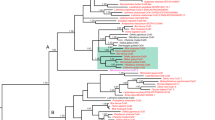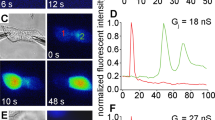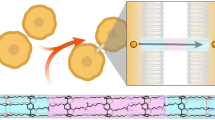Abstract
Low electrical resistance intercellular junctions have been found in a wide variety of adult tissues, both in vivo and in tissue culture1 and in early embryos2. Vertebrate and invertebrate adult intercellular junctions are permeable to small ions and a variety of other molecules, of molecular weights possibly up to 1,000, as shown by the movement of tracers such as fluorescein8 and transfer of nucleotides (‘metabolic cooperation’)3. In adult systems, such intercellular exchange is correlated with the presence of gap junctions4. In embryos, some form of specific junction is necessary to account for the observed electrical coupling after early cleavage stages5 and the presence of gap junctions has been reported5–8. Since the low resistance intercellular pathway has been implicated in the control of spatial and temporal organisation during development9, the permeability of the embryonic junction assumes some importance. There is evidence suggesting that embryonic junctions are less permeable than adult junctions10–13, which we have recently confirmed14. Our experiments14 suggested that there is selectivity in the gap junctional membrane which led us to predict that the junctional permeability would be sensitive to changes in intracellular pH. We present here results which confirm this prediction.
This is a preview of subscription content, access via your institution
Access options
Subscribe to this journal
Receive 51 print issues and online access
$199.00 per year
only $3.90 per issue
Buy this article
- Purchase on Springer Link
- Instant access to full article PDF
Prices may be subject to local taxes which are calculated during checkout
Similar content being viewed by others
References
Furshpan, E. S. & Potter, D. D. Curr. Top. dev. Biol. 3, 95–127 (1968).
Powers, R. D. & Tupper, J. T. in Intracellular Communication 231–251 (Plenum, New York, 1977).
Burk, R. R., Pitts, J. D. & Subak-Sharpe, J. H. Expl Cell Res. 53, 297–301 (1968).
Gilula, N. B., Reeves, O. R. & Steinbach, A. Nature 235, 262–265 (1972).
Sheridan, J. D. in Cell Surface Reviews (eds G. Poste & G. L. Nicholson) 1, 409–443 (North Holland, Amsterdam, 1976).
Sanders, E. J. & Di Caprio, R. A. Differentiation 7, 13–21 (1976).
Sanders, E. J. & Zalik, S. E. Wilhelm Roux' Arch. 171, 181–194 (1972).
Ducibella, T., Albertini, D. F., Anderson, E. & Biggers, J. D. Devl Biol. 45, 231–250 (1975).
Warner, Anne E. in Simple Nervous System 3–25 (Edward Arnold, London 1975).
Slack, C. & Palmer, J. F. Expl Cell Res. 55, 416–419 (1969).
Tupper, J. T. & Saunders, J. W. Devl Biol. 27, 546–554 (1972).
Bennett, M. V. L. in Intracellular Staining in Neurobiology 115–134 (Springer, Berlin, 1973).
Baker, P. F. & Warner, Anne E. J. Cell Biol. 53, 579–581 (1972).
Turin, L. J. Physiol., Lond. 269, 6P–7P (1977).
Thomas, R. C. J. Physiol., Lond. 238, 159–180 (1974).
Loewenstein, W. R. Ann. N.Y. Acad. Sci. 137, 441–472 (1966).
Meech, R. & Thomas, R. C. J. Physiol., Lond. (in the press).
Rose, B. & Loewenstein, W. R. Nature 245, 250–252 (1975).
Brachet, J. Chemical Embryology (Interscience, London, 1950).
Author information
Authors and Affiliations
Rights and permissions
About this article
Cite this article
TURIN, L., WARNER, A. Carbon dioxide reversibly abolishes ionic communication between cells of early amphibian embryo. Nature 270, 56–57 (1977). https://doi.org/10.1038/270056a0
Received:
Accepted:
Issue Date:
DOI: https://doi.org/10.1038/270056a0
This article is cited by
-
Unusual Slow Gating of Gap Junction Channels in Oocytes Expressing Connexin32 or Its COOH-Terminus Truncated Mutant
Journal of Membrane Biology (2007)
-
Opposite Cx32 and Cx26 Voltage-Gating Response to CO2 Reflects Opposite Voltage-Gating Polarity
The Journal of Membrane Biology (2004)
-
CO2 Sensitivity of Voltage Gating and Gating Polarity of GapJunction Channels—Connexin40 and its COOH-Terminus-Truncated Mutant
Journal of Membrane Biology (2004)
-
Beyond the gap: functions of unpaired connexon channels
Nature Reviews Molecular Cell Biology (2003)
-
Cytoplasmic acidification with butyric acid does not alter the ionic conductivity of plasmodesmata
Protoplasma (2001)
Comments
By submitting a comment you agree to abide by our Terms and Community Guidelines. If you find something abusive or that does not comply with our terms or guidelines please flag it as inappropriate.



